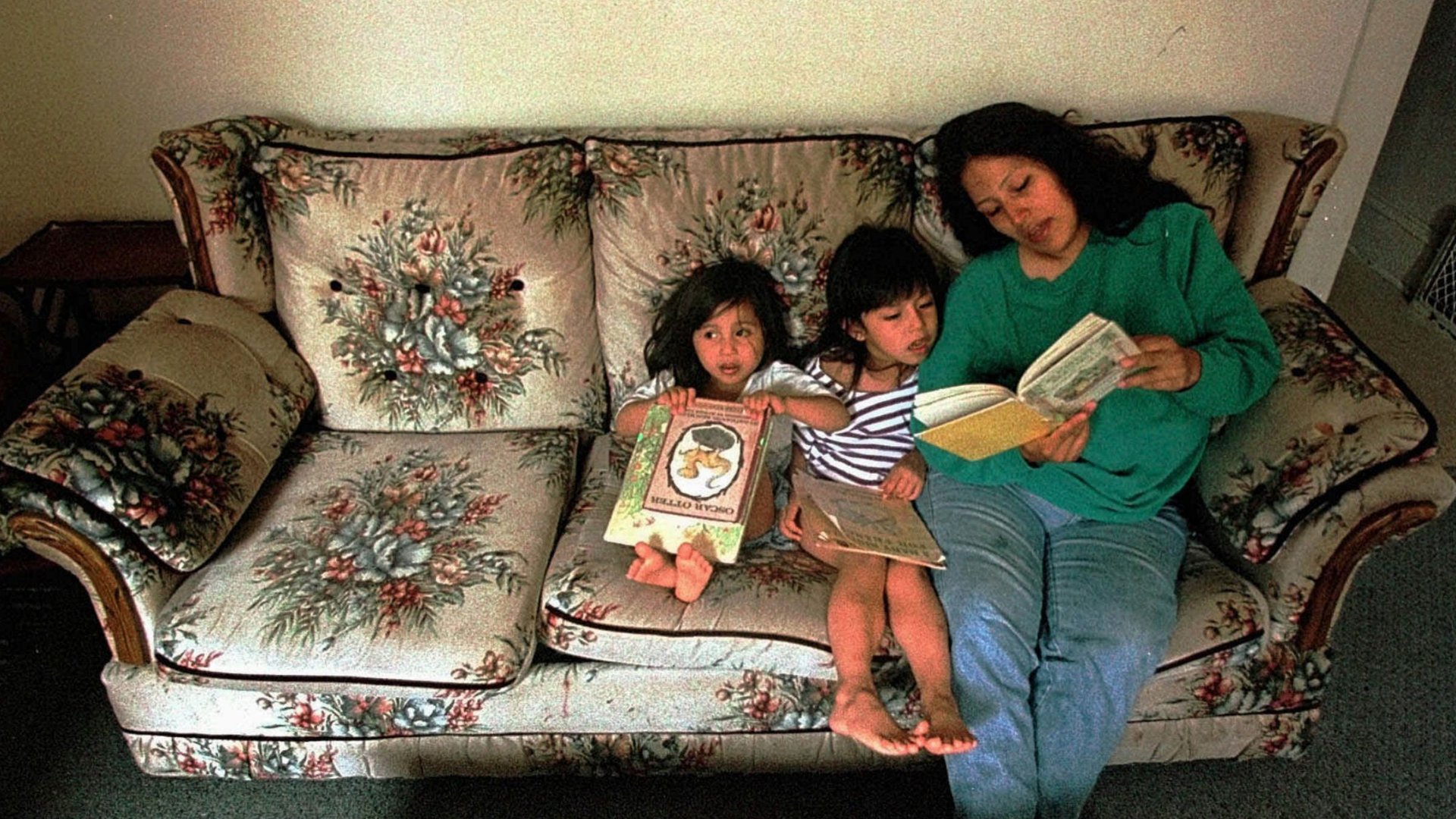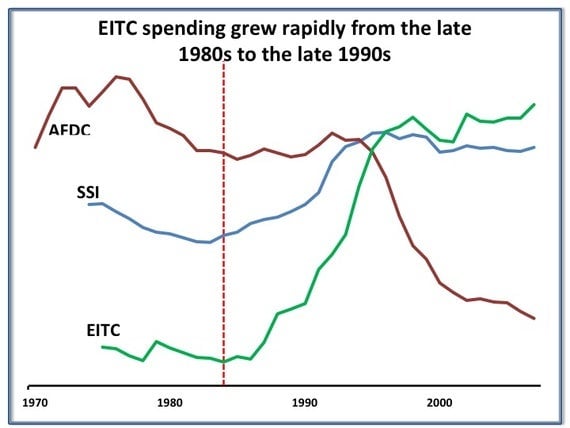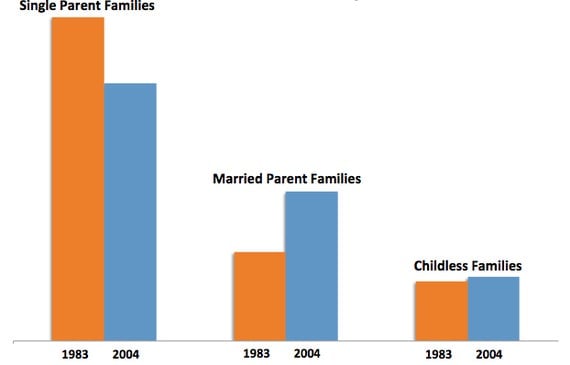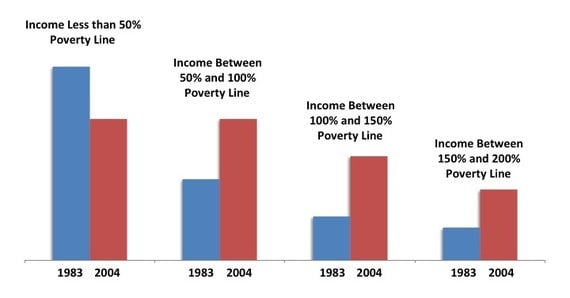The US welfare system is becoming more generous—unless you’re a single mother
Rosa Pena, a 24-year-old single mom in Arizona, told the New York Times “I’ll do what I have to do,” to stay alive, including sell the groceries she buys with food stamps. Other poor women the paper interviewed in 2012 said they sell clothes for extra cash or reluctantly move back in with violent boyfriends. “One woman said she sold her child’s Social Security number … ‘I tried to sell blood, but they told me I was anemic,’ she said.”


Rosa Pena, a 24-year-old single mom in Arizona, told the New York Times “I’ll do what I have to do,” to stay alive, including sell the groceries she buys with food stamps. Other poor women the paper interviewed in 2012 said they sell clothes for extra cash or reluctantly move back in with violent boyfriends. “One woman said she sold her child’s Social Security number … ‘I tried to sell blood, but they told me I was anemic,’ she said.”
If they can’t find work, they have few other options. Payments from Temporary Assistance to Needy Families (TANF, but more colloquially referred to as welfare), once a last resort for single mothers, have declined precipitously in the past 2 decades, even as other government programs have grown.
“Some get income from family members. Some engage in illegal activity. Some have boyfriends.”
In a forthcoming study for the journal Demography, Robert Moffitt, an economist at Johns Hopkins University, details how the poorest single-parent families—80% of which are headed by single mothers—receive 35% less in government transfers than they did 3 decades ago. Meanwhile, government spending on older and disabled adults has increased.
“We know now that there has been a large increase in total government support to low income families since 1986, but the distribution of that support has dramatically changed,” Moffitt said in a recent presentation at the Population Association of America, where he serves as president.
In 1935, Congress created 3 safety-net programs aimed at alleviating poverty: Social Security, which is for the old and disabled, Unemployment Insurance, which is for those temporarily out of a job, and Aid to Dependent Children, whose name was later changed to Aid to Families with Dependent Children. The latter is what we typically think of as “welfare”—cash transfers intended to help widows with children.
Food stamps, which go to low-income families or individuals, were added in 1964, and in 1975 came the Earned Income Tax Credit, or EITC, which goes to working families with a certain level of income.
AFDC was never flawless—it excluded black women until the 1960s—but it did become an important lifeline for poor mothers throughout the 1980s. By 1992, the majority of AFDC recipients were single mothers, rather than widows.
As more women entered the workforce, however, society began to sour on unemployed single mothers. Those drawing government benefits were derided as “welfare queens.”
“The expectation was that since middle-class women are working and supporting their families, that low-income families should be doing the same,” Moffitt told me.
In 1996, former President Bill Clinton pledged to “end welfare as we know it,” and AFDC morphed into TANF—Temporary Assistance to Needy Families. A 5-year time limit was introduced, and mothers were required to work 30 hours per week or risk losing their benefits. States’ funds were capped, pressuring them to slice welfare rolls.
The effect was that thousands of single moms were promptly shoved off the program: “The legislation reduced the number of poor single mother families served by 63% within 10 years, effectively removing it as an important program in the nation’s safety net for the poor,” Moffitt writes.
Here’s a chart showing spending on all of the benefit programs over time, which Moffitt calculated using the Survey of Income and Program Participation.

But that’s not to say we were growing more tight-fisted as a nation. Spending on these programs rose from 9% of GDP in 1985 to 12% in 2007. Between 1990 and 1995, SSI spending grew by 80% because of changes in eligibility rules. The EITC grew by 274% between 1988 and 1998. And though there were recently major cuts to the food-stamp program, it had expanded by 20% between 2003 and 2007.
Meanwhile, spending on TANF, the only program that non-disabled, non-elderly, poor single mothers are eligible for other than food stamps, was lower in 2007 than it had been in 1970.
Food stamps, meanwhile, provide an average of just $5 per day per person.
The result has been that over time, older people, disabled people, and working families have reaped the increased welfare benefits. Unemployed, single-parent families have gradually lost out.
Here’s a look at how the transfers to various groups have changed over time:

The average older adult received about 20% more from the government in 2004 than they did in 1983, but the average able-bodied, single parent younger than 62 received 20% less. And that decrease was concentrated among single-parent families who make less than half the poverty level—the poorest of the poor.

“It helps to be married and not a single person if your earnings are very low,” Moffitt said.
The 2012 New York Times story estimated that now, “1 in every 4 low-income single mothers is jobless and without cash aid—roughly 4 million women and children.”
What they do for money isn’t clear, but Moffitt listed a few possibilities.
“Some find occasional jobs, but that’s not enough to qualify them for the TANF program,” he told me. “Some get income from family members. Some engage in illegal activity. Some have boyfriends. All the indications are that they kind of scrape by.”
Moffitt is careful to emphasize that this doesn’t mean benefits to the disabled, elderly, or working families should be cut. But his findings do suggest that the stigma surrounding unwed mothers has made their economic lives much harder.
What’s interesting is that the idea of the “welfare queen” has persisted even as welfare itself has evaporated, as Amanda Marcotte pointed out in the Daily Beast. In December, Ann Coulter claimed on Fox & Friends that “single women look to the government as their husbands. Please provide for me, please take care of me.”
Even if single moms wanted to do that, though, they couldn’t.